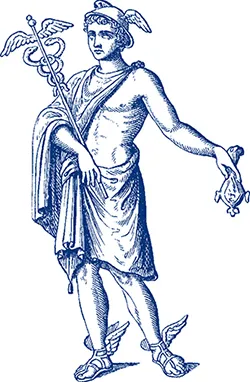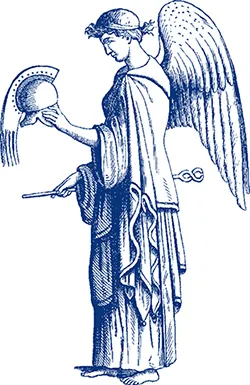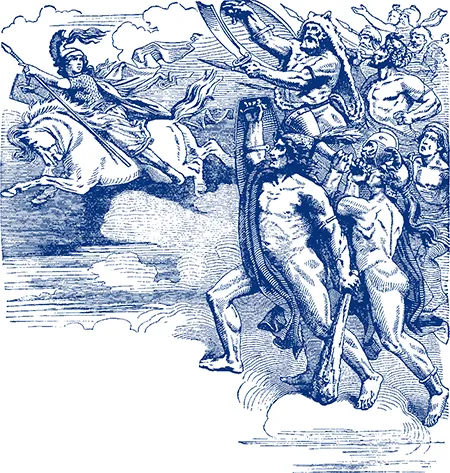![]()
PART ONE
THE
Angelic Realm
Angels are spirits, but it is not because they are spirits that they are angels. They become Angels when they are sent. For the name Angel refers to their office, not their nature. You ask the name of this nature, it is spirit; you ask its office, it is that of an Angel, which is a messenger.
—SAINT AUGUSTINE
![]()
CHAPTER ONE
Ancient Angels
It is unknown if the idea of angels arose in different cultures independently, if the idea traveled from culture to culture, or which cultural ideas seeded the beliefs of others. For thousands of years, merchants and mercenaries, wise men and priests, prophets and pagans, and those uprooted by famine or war have wandered and intermingled. Thus it is that you can find the concept of angels in the mythologies of nearly every known ancient culture. Their appearance and purpose may vary throughout the world and its history, but their universal influence over mankind is a presence of love and guidance, and a reminder that we are not alone.
THE EARLIEST ANGELS
Angels have been recorded in history by many different cultures throughout the world. Some scholars say that the earliest religious representation of angels dates back to the city of Ur, in the Euphrates Valley, c. 4000–2500 B.C.E. A stele, which is a stone slab, showed a winged figure descending from one of the seven heavens to pour the water of life from an overflowing jar into a cup held by the king. Other records show that in Mesopotamia there were giant, winged creatures—part human, part animal—known as griffins. And in Egypt, Nepthys, the twin sister of the goddess Isis, is shown in paintings and reliefs enfolding the dead in her beautiful wings.
Without doubt, based upon archeological evidence and other prehistoric information, angels were depicted long before Christianity appeared on the religious stage. Descriptions of angels are ancient, predating even early Judaism. Images of angels appear all over Asia Minor, in different cultures of the ancient civilized world, and westward into Greece and Italy. Iris and Hermes, messenger of the gods and guide of souls, both wear wings and serve angelic functions such as carrying messages and bringing aid to humans. The famous Greek sculpture of Nike, The Winged Victory of Samothrace, served as a model for the angels depicted in Renaissance art, firmly establishing the concept of angels in that period.
HERMES, MESSENGER OF THE GODS
THE MESSENGERS
The word angelos in the original Greek means “messenger,” and in this respect, angels may be related to the function of Hermes, one of whose daughters is called “angel” by Pindar. A daughter of Zeus, Iris, the “goddess of the rainbow,” is also described as an angel by the writer Hesiod. Such terms suggest that an angel is a special carrier of messages from the gods, an idea that permeates the writings about angels of many cultures.
IRIS, GODDESS OF THE RAINBOW
Winged spirits—angels—are part of the mystery of every culture. . . . The Vikings called them valkyeries. The Greeks called them horae. In Persia they were fereshta, and sometimes they were confused with peri or horis, which are sexless (yes) female celestial beings who give sensual delight to the inhabitants of Paradise; or with the Hindu apsaras, the beautiful fairies of heaven who dispensed sensual and erotic bliss to the gods, though later (especially Christian) teachings insist that angels are without carnal desire, . . . Still, in those early Indo-European myths, angels could have children, which sprouted like cabbages on their laps, already five years old at birth.
—SOPHY BURNHAM, A BOOK OF ANGELS
In addition to Hermes (who wore wings on his heels) and Iris (who is often pictured with small wings on her back) from the Greek tradition, there are angel-like figures—often called griffins—in many ancient cultures. Kneeling beside an Etruscan tombstone dating from about 100 B.C.E. are two enormous stone figures with great wings springing from their shoulders. Sometimes griffins were entirely human in appearance, as is the case of the two winged genii depicted on a cylinder seal from Assyria (c. 700–600 B.C.E.) who are thought to be fertilizing the Tree of Life. But even these remarkable representations are recent when compared to the figures from ancient Egypt, Mesopotamia, and Persia.
EGYPTIAN GUARDIANS
In ancient Egypt, the goddess Nepthys, considered along with Isis and Osiris to be one of the progenitors of the world, often appears as a winged figure. Her image is found carved on the inner right-hand door of Shrine III in the tomb of Tutankhamun, c. fourteenth century B.C.E. Tall and erect, she spreads her slender arms, to which her intricately carved wings are attached, in a sweeping motion forward, as if to encompass the dead pharaoh and protect him from all harm.
The ancient Egyptians also believed that each person had a supernatural double, called his or her ka, who was born alongside the person and remained a part of his or her life ever after. In one sense, the ka was what we today call a guardian angel, but it also represents the soul, or that part of the human being that is able to separate from the body and travel around on its own. The old Egyptians would have found nothing unusual about what we now refer to as “out of body experiences.” Instead, they would have said that their ka was simply off somewhere else, unattached to the body.
When the Angels arrive, the devils leave.
—EGYPTIAN PROVERB
Other early cultures depicted winged lions and bulls with human heads who warded off evil and stood between the realm of the myriad gods of the era and their human worshippers.
THE TRANSFORMATION OF ANGELS
Angels are also found in the Asian cultures represented by Buddhism and Taoism. The angels of ancient Assyria and Mesopotamia were a tradition carried down through Manichaean, Judaic, Christian, and Islamic lore, each of which influenced the others’ faith in angels. The concept of angels was widely accepted in Asia Minor and extended into the Mediterranean basin of Greece and Italy, where it would become embraced and transformed.
HOW MANY ANGELS ARE THERE?
Angels appear in both the Old and New Testaments, where they are mentioned directly or indirectly about three hundred times. According to David in Psalm 68:17, “the chariots of God are twenty thousand, even thousands of angels.” Some biblical scholars believe that angels can be numbered in the millions, based on the comment in Hebrews 12:22, which refers to “an innumerable company of angels.”
In Greece, the idea of angels transformed into the famous depiction of Nike in The Winged Victory of Samothrace. During the Renaissance, the once fierce cherubim changed from the awesome beings of Ezekiel’s vision—terrifying creatures with swords of fire who guarded the Garden of Eden against the return of the expelled Adam and Eve—into putti, or cute little pink baby cherubs. Childlike in form and appearance, cherubs usually floated like little Cupids around beautiful, serene women, who are often pregnant or with small children.
SHAMANISM
One of the world’s oldest religious traditions, Shamanism, as practiced by some Native Americans, incorporates communication with winged beings. These often come in the form of eagles, ravens, or spirits and are not usually associated with later angelic iconography.
I looked up at the clouds, and two men were coming there, headfirst like arrows slanting down; and as they came, they sang a sacred song and the thunder was like drumming. I will sing it for you. The song and the drumming were like this: “Behold a sacred voice is calling you; All over the sky a sacred voice is calling.”
—NICHOLAS BLACK ELK, AS TOLD THROUGH JOHN G. NEIHARDT IN BLACK ELK ...




